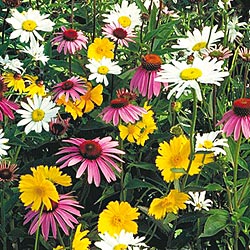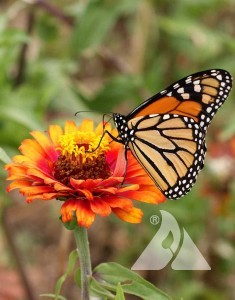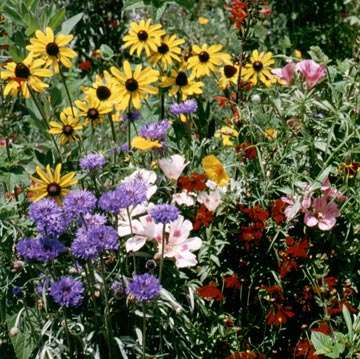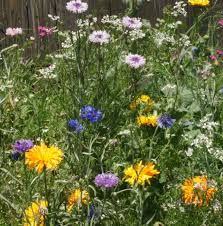Regional and Special Use Seed Blends

15g pack will cover 100 sq. ft.

The beautiful orange and black Monarch butterfly is one of the best known threatened butterfly species in North America. According to some of the latest surveys over 90% of the population has disappeared in the last decade mostly due to loss of habitat. Sprawling urban developments and intensive farming techniques mean fewer uncultivated margins where the milkweed species can thrive and provide habitat for the Monarch during its egg and larvae/caterpillar stages.
When the females cannot find suitable habitat to lay eggs, the life cycle is interrupted and the overall population decreases. While scientists have been aware for several years of the Monarch butterfly's life threatening situation and possible extinction, promoting public, government and industry awareness of the plight of this beautiful insect is probably the only thing that can lead to saving it.
This mix provides five species of milkweed (Asclepias) as well as a Butterfly Mixture that provides a variety of nectar-producing flowers that supply food for adult butterflies. Milkweed (Asclepias species) is the only food source for Monarchs in their caterpillar state, and any garden devoted to butterflies will have Milkweed in abundance. This mix offers a bit of it as well, but it supplements with greater percentages of many other nectar sources (often more difficult for Monarchs to find) for spring, summer, and fall.
This mix contains: Bishop's Flower, Black-Eyed Susan, Butterfly Milkweed, California Poppy, Candytuft, Cornflower, Dwarf Cosmos, Lance-Leaved Coreopsis, Dwarf Godetia, Indian Blanket, New England Aster, Plains Coreopsis, Gayfeather, Purple Coneflower, Perennial Lupine, Purpletop, Shasta Daisy, Siberian Wallflower, Sweet Alyssum, and Sweet William Pinks.
2 ounce package of seeds will cover 300 square ft.


Contains: Coneflower, Arroy Lupine, Mallow, Four-O'Clock, Nasturtium, Zinnia 'Pumila Mix', Bird's Eyes, Rocket Larkspur, Sweet William Pinks, Spurred Snapdragon, Corn Poppy, Scarlet Sage, Catchfly, Balsam, Dwarf Columbine, Foxglove, Maltese Cross, Lemon Mint and Rocky Mountain Penstemon.
Sow seeds in February in South, April in the North.
18g package of seeds will cover 100 square ft.

Mix Includes: Borage, with a cucumber-like flavor; Cilantro, with its tangy, fresh flavor and aroma; Nasturium, whose bright yellow, orange and red blooms have a spicy, pepper-like flavor; Calendula, which has a yellow-orange flower and a mild, peppery flavor; Cornflower, with its bright blue flower and mild taste; Dianthus with a clove-like flavor; onion-flavored Chives; Lemon Mint, which has a strong mint flavor; Pansy and Johnny Jump-Up, both with brightly colored flowers with a mild, slightly sweet flavor; licorice-flavored Lavender Hyssop; and English Daisy, also a lovely flower with a sweet, mild flavor.
2 ounce package of seeds will cover 200 square ft.
Seed Sowing: Method of application depends on the size of the area and the terrain. On small areas, broadcast seeds evenly either by hand or by use of a drop or cyclone spreader. It is helpful to mix a carrier such as clean, dry sand with the seed; sand adds volume and aids in even distribution. We recommend using a ratio of 1 or 2 parts sand to 1 part seed. Rake in lightly, covering seeds to a maximum depth of 2-3 times their thickness. Or drag the area lightly with a piece of chain link fence to mix the seed into the surface of the soil.
Moisture:
All seeds, including wildflowers, need ample moisture to germinate and to develop into healthy seedlings. Best results will be obtained by soaking the planted areas thoroughly and maintaining consistent moisture for 4-6 weeks, then gradually reducing waterings. In non-irrigated situations, plant in the spring or before periods of anticipated rainfall. After seedlings are established, watering may be reduced depending on the climate and rainfall. In arid climates or during drought conditions, up to 1/2 inch of supplemental water per week may be required to maintain an optimal display. If weeds are present, remember that they benefit from moisture as much as the wildflowers and may dominate overwatered areas.
Fertilization
Many wildflowers benefit from some fertilization if the soil does not have adequate nutrients. Some wildflowers do fine in poor soils, while others require a more fertile environment. We recommend that a soil test be performed when soil quality is unknown. If the soil needs improvement, use a low nitrogen fertilizer with a 5-10-10 ratio or add organic matter such as weed-free straw or grass clippings, well-rotted compost, peat moss, or leaf mold. In addition to adding nutrients, organic materials enhance soil structure and encourage beneficial microorganisms. Avoid over-fertilizing which may promote weed growth and lush foliage rather than flowers.
Weed Control: Weed control is the biggest problem facing plant establishment and one which has no easy solution. Weed seeds are present in many situations and lie dormant, but viable, for long periods. A weedy area converted to wildflowers will have a large reservoir of weed seeds in the soil, ready to germinate when conditions are favorable. In most cases, it is advisable to consider weed control in two phases part of site preparation prior to planting, and as an important component of the post-germination maintenance program.
Before planting, remove existing weeds by pulling, tilling under, applying a glyphosate herbicide, or by a combination of these methods. For additional weed control after site preparation, a soil fumigant may be used, or the area may be irrigated to encourage weed growth and then sprayed with a general herbicide.
In very weedy areas, the following method is suggested: (1) Till soil or spray vegetation with glyphosate herbicide. When using an herbicide, allow vegetation to die, then rake out the dead debris.
If perennial weeds such as bindweed are present, using an herbicide is more effective than tilling. (2) Irrigate to encourage germination of weed seeds near the surface; most seeds will germinate within two weeks if consistent moisture is available. Do not till the soil again because this will bring even more weed seeds up to the surface. (3) Spray any new growth with glyphosate herbicide. (4) After raking out dead vegetation, allow soil to recover for 3-4 weeks before planting seed. From our experience, a recovery period of this duration is advisable because extensive use of glyphosate herbicides may cause a delay in germination and in the vigorous growth of seedlings.
Once the seeds have germinated, further weed control is usually necessary. If practical, pull all weeds as soon as they can be identified.
Other successful techniques are spot-spraying with a general herbicide or selectively cutting weeds with a string trimmer. Be sure to remove weeds before they reseed.
What to Expect: Wildflowers can provide an excellent, low cost alternative in large-scale, high maintenance situations, as well as a satisfying change from traditional urban landscaping. However, during their initial establishment period, wildflowers require as much maintenance as traditional plantings.
A smooth, weed- and vegetation-free planting bed is important for good seed-soil contact and prompt germination. Avoid seeding more than the recommended rate since overseeding can result in crowded conditions the first year and poor establishment of perennials. Cover seeds lightly to protect them from drying out during germination, and to prevent them from being eaten by birds. Consistent moisture is important for 4 to 6 weeks after planting.
A wildflower planting requires the same weed control measures as traditional landscaping. Effective measures include site preparation prior to planting and a post-germination maintenance program.
Most wildflower mixes contain annual, biennial and perennial species. The annuals, which may not be native to your area, are included to assure maximum color during the first season and to act as a nurse crop for the slower-growing perennials. Annuals germinate quickly when conditions are favorable, providing a quick ground cover and competition against weeds. Natural reseeding of annuals ranges from significant to minimal, depending on the species, climate, soil texture and other factors. Most perennial and biennial species begin to bloom the second season, but not as profusely as annuals. Therefore, wildflower plantings look noticeably different after the first year.
Sometimes it is desirable or even necessary to sow seed in second and subsequent years. Reseeding may be necessary if establishment of wildflowers is spotty or poor. It is possible to reseed bare areas with the original mixture. Loosen soil of bare areas and provide adequate weed control and supplemental irrigation as needed. Where natural reseeding of annuals is minimal, sowing annuals each spring can produce a magnificent annual and perennial display throughout the growing season.
If desired, wildflowers may be mowed in the fall following seed set. Mow to a height of 4-6 inches, and leave the residue on the ground because it is a reservoir of viable seeds.

